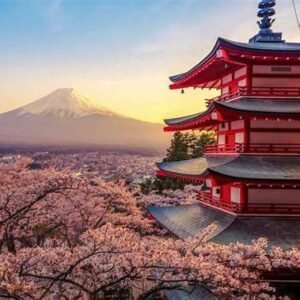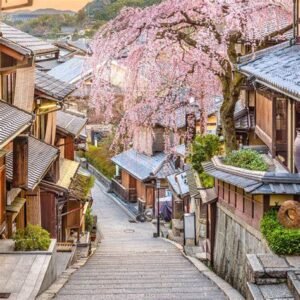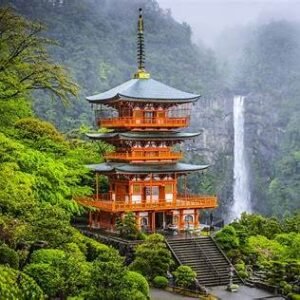



The first time I arrived in Japan, my itinerary looked just like most first-time travelers’—Tokyo, Kyoto, maybe Osaka squeezed in between. And while I loved the neon skyscrapers of Shinjuku and the golden stillness of Kinkaku-ji, something felt unfinished. I wanted to know what lay beyond the postcards, beyond the headlines. It wasn’t until my second trip that I discovered the best places to visit in Japan are often far removed from the familiar names.
In 2025, travel has shifted. More than ever, visitors are seeking authenticity, mindful exploration, and quieter corners where culture still breathes unfiltered. That’s exactly why venturing beyond Tokyo and Kyoto matters. This is where Japan reveals itself as a mosaic—ancient shrines tucked in forests, hot springs steaming under snowy peaks, fishing villages where traditions outlive trends, and tropical islands where coral reefs outshine neon lights.
Come with me on this narrative journey. Together, we’ll wander through Japan’s hidden frontiers, finding the balance between past and present that makes this country endlessly fascinating.
Why Look Beyond Tokyo and Kyoto?
Tokyo and Kyoto dominate most itineraries, and for good reason—they are extraordinary cities. But limiting your trip to them is like reading only the first and last chapters of a novel. The best places to visit in Japan are scattered across its islands: rural towns where samurai once walked, volcanic valleys that reshape the land even today, and seaside sanctuaries where time feels slower.
Travel in 2025 is about depth. Exploring regional Japan means supporting small businesses, embracing sustainability, and seeing the country as locals live it—layered, imperfect, breathtaking.
Hokkaido: The Untamed North
Japan’s northernmost island, Hokkaido, feels like an entirely different country. With vast wilderness, indigenous Ainu heritage, and a climate that swings from lavender summers to snow-swept winters, it’s one of the best places to visit in Japan for those who love the outdoors.
Furano and Biei: Fields Painted with Color
In July, the hills of Furano turn into lavender seas, their fragrance carried by summer winds. Nearby Biei is a patchwork quilt of rolling farmlands, where the earth itself feels like a canvas. Cycling along the narrow roads, I felt like I had slipped into a watercolor painting.
Shiretoko Peninsula: Edge of the Earth
Designated a UNESCO World Heritage Site, Shiretoko is raw and almost primeval. Brown bears roam the forests, orcas slice through the cold seas, and in winter, drift ice from Siberia grinds against the coast. Standing on a cliff here, I understood why the Ainu people consider it sacred.
Sapporo: Snow, Beer, and Ramen
The capital of Hokkaido is famous for its February Snow Festival, when sculptors transform ice into entire palaces. At night, I warmed myself with Sapporo miso ramen—a steaming bowl that seemed designed to chase away the cold.
Kanazawa: Kyoto’s Quieter Cousin
If Kyoto is a stage, Kanazawa is a whisper. Once a samurai stronghold, this city preserves tradition without the crowds.
Kenroku-en Garden: Nature as Poetry
Considered one of Japan’s “Three Great Gardens,” Kenroku-en is stunning in every season: cherry blossoms in spring, irises in summer, red maples in autumn, and pines dusted with snow in winter. Wandering its stone paths feels like drifting through a living poem.
Samurai and Geisha Districts
Kanazawa’s Nagamachi district, once home to samurai families, still echoes with wooden gates and earthen walls. Higashi Chaya, its geisha quarter, glows in the evening lantern-light. Here, Japan’s Edo past still lingers.
Takayama and the Japanese Alps
The Japanese Alps are a world of mountain traditions and snowy silence.
Takayama: A Time Capsule
Takayama’s old town preserves narrow streets lined with wooden houses and sake breweries. Morning markets brim with fresh produce, miso, and crafts. Walking here feels like stepping back into the Edo period.
Shirakawa-go: A Fairy Tale in Snow
A bus ride away lies Shirakawa-go, a UNESCO World Heritage site. Its thatched-roof houses, shaped like praying hands, glow warmly when lit in winter. I visited during the January illumination, when the village looked like a snow globe shaken to life.
Shikoku: Pilgrimage and Peace
Shikoku is the least visited of Japan’s four main islands, yet spiritually, it’s among the richest.
The 88-Temple Pilgrimage
For centuries, pilgrims have walked Shikoku’s 1,200-kilometer loop of 88 temples, following the path of the monk Kukai. In 2025, more travelers are discovering it, seeking not just religion but reflection.
Iya Valley: Japan’s Hidden Heart
Few places feel as untouched as the Iya Valley. Here, vine bridges sway across deep gorges, hot springs steam in silence, and legends say samurai refugees once hid after their defeat in battle.
Kyushu: Volcanoes, Hot Springs, and History
Kyushu is a land of fire and resilience.
Mount Aso: Earth’s Trembling Heart
With one of the world’s largest volcanic calderas, Mount Aso is awe-inspiring. Standing on its rim, I felt the earth breathing.
Beppu and Yufuin: The Call of the Onsen
Beppu is famous for its “hells”—steaming geothermal pools in surreal colors. Yufuin, a smaller town nearby, offers boutique inns where hot springs are paired with mountain views.
Nagasaki: Memories and Multicultural Echoes
Nagasaki, once Japan’s window to the world, still reflects Dutch, Portuguese, and Chinese influences. Its Peace Park is a solemn reminder of the past, while Chinatown buzzes with flavors from beyond.
Okinawa: Japan’s Tropical Soul
South of the mainland, Okinawa feels like another world.
Beaches and Reefs
Okinawa’s beaches rival any in Southeast Asia. On Ishigaki Island, I dove into reefs swarming with manta rays. On Miyako, I strolled endless white sands under a turquoise sky.
Ryukyu Spirit
Before joining Japan, Okinawa was the Ryukyu Kingdom, and its heritage is still alive—in its music, castles, and dances. The rhythm of sanshin instruments lingers in the air long after the sun sets.
Seasonal Highlights Across Japan
-
Spring: Cherry blossoms bloom first in Kyushu and sweep northward to Hokkaido.
-
Summer: Fireworks festivals light up riversides across the country.
-
Autumn: Maple leaves turn mountains into red-gold waves, especially in Nikko and Arashiyama.
-
Winter: Snow monkeys bathe in hot springs in Nagano, a sight that feels almost human.
Practical Tips for 2025 Travelers
-
Rail Travel: The JR Pass remains essential for multi-city journeys.
-
Cash Matters: Rural Japan still prefers yen notes and coins.
-
Respect Rituals: Bowing, temple etiquette, and silence in sacred spaces are key.
-
Travel Light: Many inns lack elevators; luggage forwarding services are lifesavers.
-
Sustainable Choices: Stay in family-run ryokan, shop from artisans, carry reusable bottles.
Conclusion: Japan’s Many Faces
The best places to visit in Japan in 2025 are not limited to Tokyo and Kyoto. They are scattered across snowy peaks, island shores, sacred trails, and quiet towns where the old and new still converse. To wander beyond the obvious is to uncover Japan’s true gift: a country that never shows all its cards at once, but always leaves you wanting to return.
For those who look deeper, Japan is not just a destination. It is a journey into time, memory, and wonder.The Best Places to Visit in Thailand


